A few years ago, Non-Fungible Tokens (NFTs) took venerable auction houses, museums, fairs and other major players of the art world by storm. Many mainstream art magazines hailed NFTs not only as a “great investment”, but also as a godsend for digital artists who can finally be paid for their work. NFTs are also said to be “more democratic” because they make art collecting affordable for people with modest budgets. But what about the astronomical amount of electricity consumed by the technology behind NFTs? The volatility concerns? Or the safety? And, perhaps more interestingly, can you create NFTs while also being critical of its market and infrastructure?
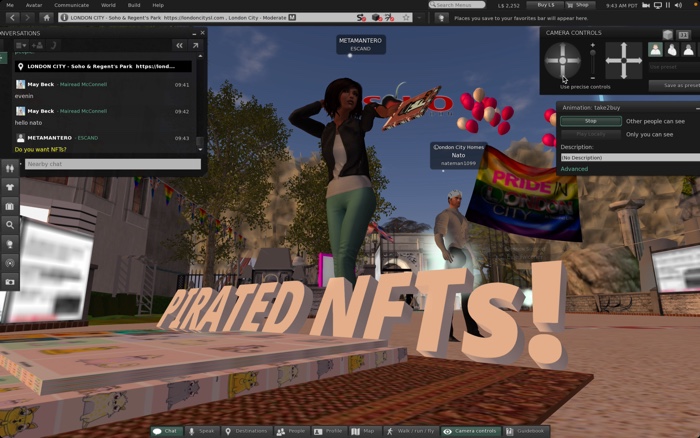
César Escudero Andaluz, METAMANTEROS, Digital activists in Web3, 2022
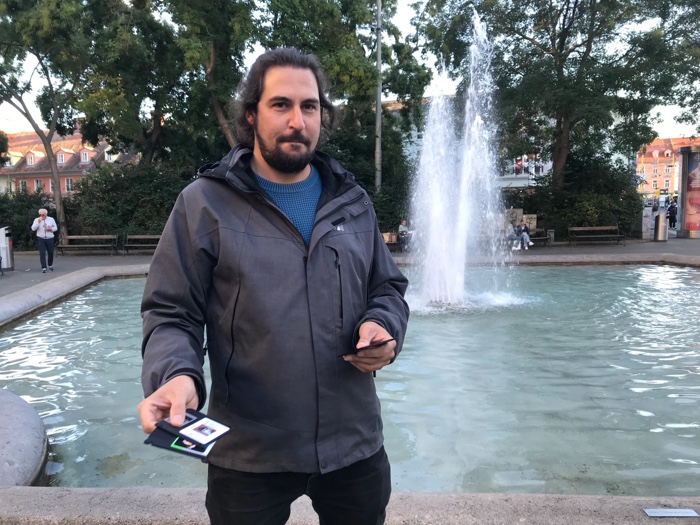
César Escudero Andaluz, Guerrilla NFT, 2022
When I don’t know what to make of a phenomenon or when I feel that my view of it lacks nuance, I turn to artists. I look for someone whose research and artworks scrutinise the social, political or ethical dimensions of a technology and then I ask them if they have a moment for an interview. César Escudero Andaluz (whom I interviewed in the past) is going to be my Virgil in this descent into the depths of NFT.
Earlier this year, César organised a workshop addressed to those who have some doubts and questions about NFTs, blockchain, the metaverse and digital culture in general. Participants were invited to create an avatar able to sell pirate NFT in Second Life but then they also downloaded NFTs, recorded them on floppies and collaborated in a performance by selling the pirated NFTs in public spaces. The new “business” had the objective to “empower artists to research and develop critical practices that explore the socio-political potential of NFT technology.”
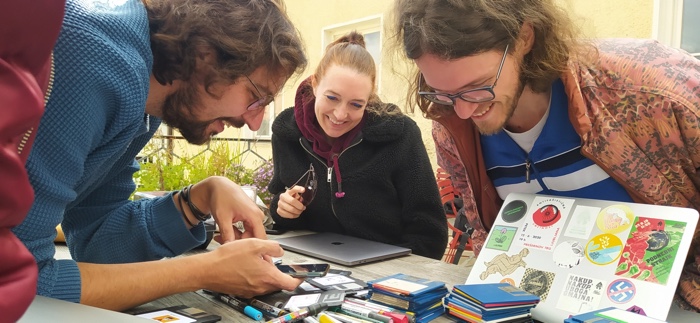
César Escudero Andaluz, Guerrilla NFT workshop, 2022
César Escudero Andaluz, Guerrilla NFT, 2022
The workshop was part of an ongoing art project called Metamanteros, digital activist in Web3. A few words about the name “Metamanteros” first. I won’t insult you with an explanation of Meta. The second part of the word is a reference to the manteros (“blanketmen”), the street vendors who sell counterfeit goods on the street, such as music CDs, bags, video games, clothes, watches, etc. They sell their products on the street on a blanket (manta) and fold the blanket back with all the goods inside and run when they notice the police presence. In Spain, Manteros are migrants from countries such as Senegal and Guinea-Bissau, usually forced by mafias to work.
Metamateros consists in the creation of 3D avatars that act as digital migrants who travel anonymously from metaverse to metaverse, (Mozilla hub, Decentraland, Sandbox, cryptovortex or Zuckerberg’s metaverse) trading data and digital assets.
The Metamanteros series is witty and a bit provocative. Ultimately, however, the works are about artistic precariousness, the price of human labour and the resistance against artificial scarcity, speculation in the art market and what the artist calls the tokenisation of everything.
César Escudero Andaluz is an artist, a researcher and a lecturer at Interface Cultures at University of Arts in Linz. He also organises the annual event Sankt Interface (which starts today at 5pm CET.)
César not only explained to me the many ways that NFTs instrumentalise the infrastructures and processes of digital art creation. He was also generous enough to point me to other artists’ and researchers’ works.
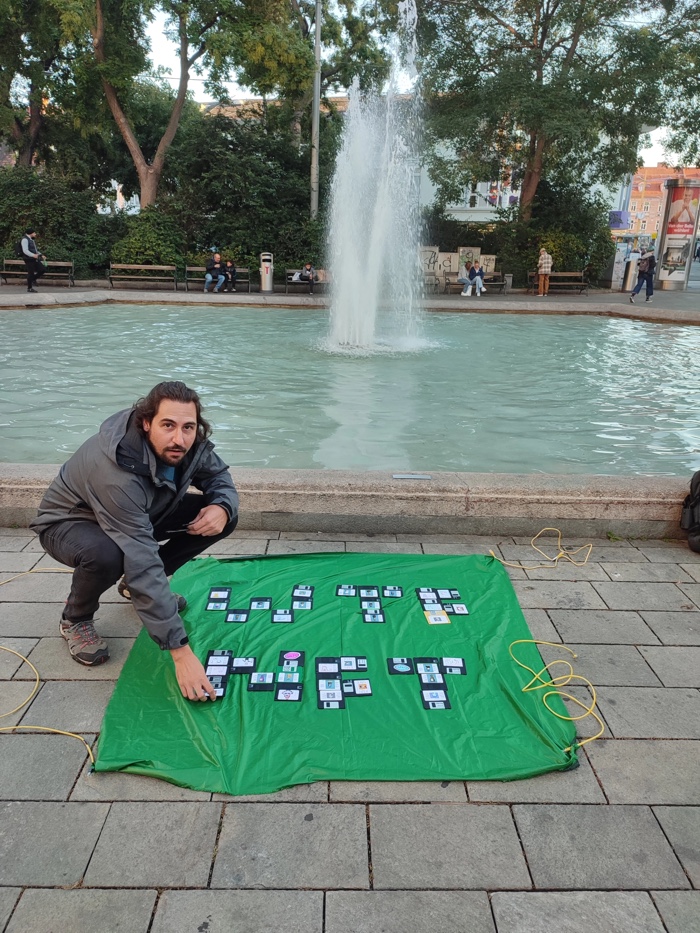
César Escudero Andaluz, Guerrilla NFT, 2022
Hi César! The Guerrilla NFT Workshop was “addressed to those who have concerns with NFTs, blockchain, the metaverse, media Art, digital culture, critical economy and hacktivism.” I follow more or less what happens in contemporary art (and by that I mean the more conventional gallery, collectors and fair type) and I don’t see many people concerned with NFT. So I’m curious about the kind of people that the workshop attracted. Are they just curious people, other artists or potential collectors of NFTs? What motivated people to join the workshop?
Hi Régine, I’m glad you ask me this question, this workshop was one of the outcomes of (Un)sustainable?! art in residency launched in 2022 by mur.at. The intention of this open call was to support artists who explore in their artworks the concept of sustainability in technology. This workshop was presented during the”Worklab” session, also hosted by mur.at together with all the artists who participated in the residency, theorists from the city of Graz and other art production initiatives such as Servus.at, or the Interface Cultures department from the art university of Linz.
In this Guerrilla NFT workshop, I introduced theoretical concepts, examples, artworks and books to understand the world of NFTs and then I proposed the practical part consisting in a collaborative performance by selling pirated NFTs in public spaces, which previously we downloaded and we stored in floppy disks.
But, answering your question… No, this Worklab did not attract anyone related to the art market, galleries, collectors or art fairs, the reason is that they are generally not interested in developing new artistic methodologies or critical thinking and because they generally do not support artists in their first years of career. They are interested in selling artistic products that give them economic benefits. But, art is not only about money, but art is also about society and it is about experiences of learning methodologies and political approaches. Art creates cultural awareness. Art gives consensus to the reality that is not written at the stroke of a chequebook.
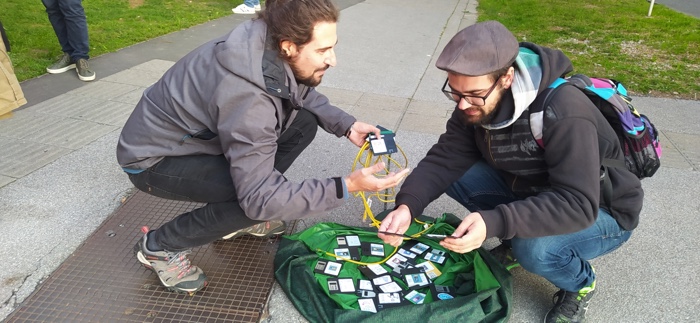
César Escudero Andaluz, Guerrilla NFT, 2022
My question will probably sound very naive but could you imagine bringing similar critiques and conversations to a contemporary art fair?
An NFTs fair would be a great context for the Guerrilla NFT performance, to enter into dialogue and place on the table issues that matter to artists, especially the economic ecosystem of emerging artists. But, it is not the only place to bring this discourse, for example the economist and digital policy expert Francesca Bria talks in an interview in the platform The Crypto Syllabus about the need to begin a process of liberating artists from the data extractivist clutches of Spotify, and therefore of the so-called “creator economy”. Bria argues that for the contextualisation of art and culture we need to pay for them as public goods, not as something funded by advertising or data collection or any other “Web3” model.
Continuing with this discourse, the artist and researcher Geraldine Juárez argues that in web3 the assets are not the content, the assets are the object of interest of investors and calls it: a situation of subversive opportunism, in which investors believe they are doing something good and proclaim that artists should participate to create a “slightly better capitalism”. In addition, the art media researcher Martin Zeilinger argues that these platforms have full control not only over information about all sales, prices, artists, etc. but can position artists and give them visibility and the resulting revenues, which can be seen as a form of control that Zeilinger compares to the treatment of creators throughout the history of intellectual property regimes. Contributing to these platforms is therefore not a form of artistic liberation, but a return to regimes of control over creativity. Zeilinger argues that it is important for activists and artists to be treated as professionals whose work performs crucially important tasks in exploring the socio-political, economic and aesthetic potentials of this technology.
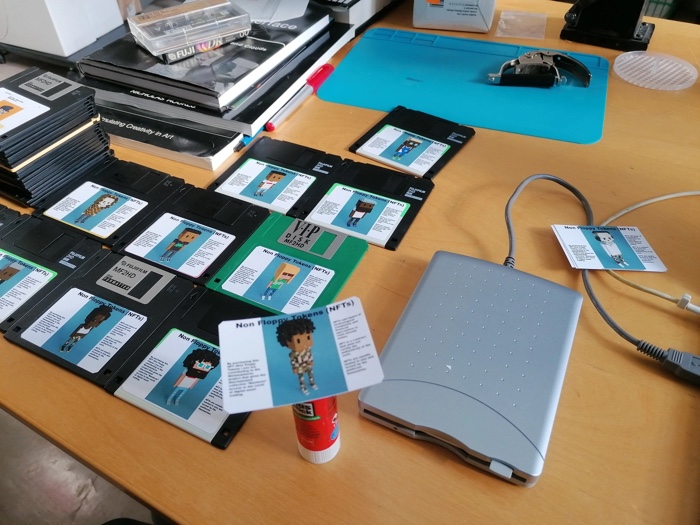
César Escudero Andaluz, Guerrilla NFT, 2022
I also wonder about your tactics and tools. First of all, in Guerrilla NFT, you use supports like floppy disks! And in the Metamanteros performance, you try to engage users of Second Life in critical discussions about NFTs. Why did you decide to work with a platform and a support format that have a bit of a vintage aura?
I chose to work with Second Life because, even though it is one of the oldest Metaverses, it is the one that gives users the most freedom to customise avatars. I tried to do the same in other platforms like Decentraland and the possibilities were restricted by an interface that only let you choose between a few predetermined possibilities. Also SL was more active and the users were more interesting.
The reason why I used floppy disks is that after analysing the characteristic of NFTs I concluded that NFTs add layers of complexity to what already exists. It seemed to me that nowadays to find an obsolete floppy disk reader is also adding another degree of difficulty in accessing information.
Your work attempts to resist the “tokenisation of everything.” What do you mean by that?
The tokenisation of everything is one of the threats posed by the model proposed by Zuckerberg in his Metaverse and also in NFT videogames such as Etheremon, or “Fishbank Alpha” based on Ethereum smart contracts. These new metaverses and video games aim to be the result of the experimentations that web3 platforms have made within the art world, producing artificial scarcity, and creating and controlling new markets in which artists and users are treated as consumers of a valuable service. In the words of the professor of Digital Culture and Network Theories Felix Stalder: ”there is an excess of utopian thinking.” In the metaverse, avatars can move and interact with other avatars and other metaverses, but also trade tokenised objects, books, music, movies and other services. Behind the scenes, the intention of all these platforms is to turn digital objects into unique and saleable entities.
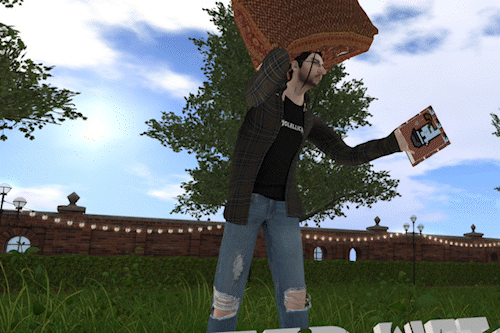
You also link NFTs with human labour, artistic precariousness, speculation in the art market, etc. But doesn’t NFT provide artists with an opportunity to subvert/hijack/sabotage and push back against the capitalistic mechanisms your work denounces?
No. The NFTs inhabit the Blockchain, and the Blockchain, as David Golumbia explains in his book The Politics of Bitcoin is a form of cyberlibertarianism, –a system where government and banking currently have no jurisprudence, and the capital has all the power. In this direction, all NFTs platforms are raised with the aim of promoting the creation of digital assets, as well as encouraging the dissemination and trade of digital art objects and the authentication of digital artworks on Blockchain. On the other hand, it is true that some digital creators have been rewarded for their activity. I am happy for them.
Your essay Metattention. Art and economy in the age of behavioural modification explains that Metamanteros are provided with “a manual refusing to work for free and trade in virtual environments through unsustainable NFTs.” That is another issue I keep wondering about. I see tweets by critical digital artists who say they have just created an NFT in a “sustainable way”. Is it possible? Can you really make “green NFTs”?
In early 2021, Martín Nadal and I came up with the idea of creating a manual to dismantle capitalism and to advise and warn artists about the consequences and dangers of playing with NFTs. This idea was developed and presented in the framework of the artist in residency EAE (Experiments in Art & Economics) (Experiments in Art & Economics), which we were invited to participate in by the initiative In4art and the museum of art and new media ZKM. This workshop brought together artists, researchers and economists such as the art collective RYBN, Livia Nolasco-Rozsas, Ludger Brummer, Stefano Puntoni, Rodolfo, Lija Groenewoud van Vliet and more, in a series of online meetings and a final presentation of the results at the ZKM. EAE is an initiative to rethink the economy through artistic experimentation, unfortunately the project is paralysed due to lack of funds.
But, answering your question. Yes, we could talk about several approaches, one is ecological and another is economical. In terms of energy consumption, most of the NFT platforms are powered by the Ethereum blockchain that was Proof of work (PoW) until September 2022, this means that in order to avoid double expending, the system relies on a network of distributed miners, a network where anyone can participate and get a reward in the form of cryptocurrency, but this network of miners (computers) has grown so much that the expenditure of electricity and resources could be compared with a country like Portugal. Additionally, a simple Ethereum transition of a few euros or one NFT is equivalent to the energy consumption of a USA household for 4.51 days, or the equivalent of a carbon footprint of more than 160,000 VISA transactions, or 12,412 hours of watching YouTube.
For this reason some artists such as Memo Akten or Kyle McDonald denounced the situation that Martin Nadal and I have been denouncing since 2016 with our work Bittercoin, the works miner ever. In 2021 Memo Akten, launched his project CryptoArt.wtf, a website that shows in real time the costs of minting, bidding and selling images from NFTs markets in terms of energy use and Co2 emission. The site displayed NFTs and creator’s information, time, transactions and a visualisation of data comparing years of electricity consumption per person, hours of flying and driving, and other normal life actions such as boiling water, using a computer, etc. It is also true that Etherum, after 8 years, has changed to Proof of Stake (PoS) ending any idea of decentralization at the same time.
The second part, the economically unsustainable part, falls on the creator and by this I mean the cost of minting, gas fees, account fees and listing fees which is proportional to the cost of the cryptocurrency. Minting an NFT in Ethereum can vary between $50-$100, depending on the price of ETH. This means that on the web3 artists pay for exhibit and for to try to sell their creations. The ¨Metamanteros¨ and the ¨NFT guerrilla¨ take up these discourses of economic unsustainability when as poor artists they tried to adapt their practices to this new economic model. In their performances, the Metamanteros shows a certificate of fake that collects all the conclusions of my research:
1-. NFTs are not a new paradigm of art.
2-. NFTs add layers of technological complexity and financial speculation to what already exists.
3-. NFT is a contract that does not certify the authenticity of the work.
4-. NFTs market spaces adopt the established rules of the art market.
5-. NFTs are certificates that do not imply exclusive use of an artwork.
6-. NFT market spaces set up economic barriers by requiring artists to invest upfront in the purchase of cryptocurrencies and the minting of NFTs.
7-. NFT platforms can be cheap to start with and can make the price more expensive, making it inaccessible for low income artists.
8-. Some NFT platforms restrict access by invitation (just like the old art market.)
9-. Open access NFT platforms have no quality filter and no expert jury, so they are overcrowded with poor-quality works.
10-. NFTs are usually limited in size and format by the platforms themselves.
11-. An NFT does not ensure that the work is authentic or original.
12-. NFTs aim to generate artificial scarcity through the blockchain.
13-. Once the NFT is minted, artists have to use their own techniques and contacts to sell it.
14-. There is no transparency on NFT data sales. Sometimes sales do not cover the costs of minting.
15-. NFTs can also diminish race, gender and geopolitical inequalities.
16-. Playing with NFTs at the marketplace minting, selling and collecting can provoke addiction.
17-. NFT platforms limit interaction to mint, buy and sell NFTs, they do not give the option to chat between sellers who are forced to migrate to other platforms to do so.
18-. Digital art has been issuing certificates of authenticity for decades without the need for blockchain.
19-. NFT market spaces encourage the creation of content, but deactivate the critical potential of the artist who participates in them.
20-. The metaverse is an experiment in terms of new forms of control and platforming.
21-. The metaverse alters rules, prices and quantities, with and without real-world consequences.
22-. The value of digital assets in the metaverse depends on their success and continuity.
23-. The metaverse is an incentive to capture users’ attention. This is the so-called attention economy.
24-. The intention of all these platforms is to turn digital objects into unique and saleable entities.
25-. In terms of creativity they propose nothing new and the possibilities to interact with them are limited by restrictive interfaces.
26-. In a Dapp there is nothing distributed, they are normal web applications.
27-. NFT platforms and metaverses do not empower artists, but rather serve to finance digital creative practices by restricting the critical potential of digital and potentially non-commercialised artistic production and expression.
28-. Web3 platforms have total control not only over information on all sales, prices, artists, etc.,
29-. Contributing to these platforms is therefore not a form of artistic liberation, but a return to regimes of control over creativity (Zeilinger, 2018.)
30-. NFTs not only produce artificial scarcity, but also aim to create and control new markets in which artists and users are treated as consumers of a valuable service (Zeilinger, 2018.)
Thank you César!
Previously: César Escudero Andaluz. So many ways to mess up with surveillance capitalism, Artists Re:Thinking the Blockchain, Value extraction and the workforce of the cryptocene, etc.
